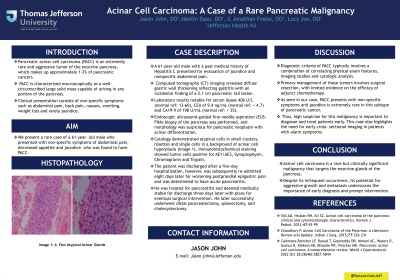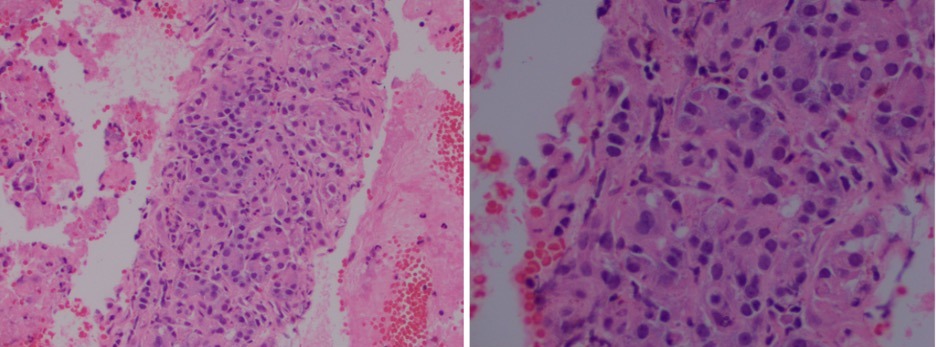Sunday Poster Session
Category: Biliary/Pancreas
P0073 - Acinar Cell Carcinoma: A Case of a Rare Pancreatic Malignancy
Sunday, October 22, 2023
3:30 PM - 7:00 PM PT
Location: Exhibit Hall

Has Audio

Jason John, DO
Jefferson Health
Stratford, NJ
Presenting Author(s)
Jason John, DO1, Neethi Dasu, DO2, C Jonathan Foster, DO3, Lucy Joo, DO3
1Jefferson Health, Stratford, NJ; 2Jefferson Health, New Jersey, NJ; 3Jefferson Health, Cherry Hill, NJ
Introduction: Pancreatic acinar cell carcinoma (PACC) is an extremely rare and aggressive tumor of the exocrine pancreas, which makes up approximately 1-2% of pancreatic cancers. PACC is characterized macroscopically as a well-circumscribed large solid mass capable of arising in any portion of the pancreas. Clinical presentation consists of non-specific symptoms such as abdominal pain, back pain, nausea, vomiting, weight loss and jaundice. We present a rare case of a 61-year- old male presented with non-specific symptoms of abdominal pain, decreased appetite and jaundice found to have PACC.
Case Description/Methods: A 61 year old male with a past medical history of Hepatitis C presented for evaluation of jaundice and nonspecific abdominal pain. Computed tomography (CT) imaging revealed diffuse gastric wall thickening reflecting gastritis with an incidental finding of a 2.1 cm pancreatic tail lesion. Laboratory results notable for serum lipase 406 U/L (normal ref: 13-60), CEA of 9.4 ng/mL (normal ref: < 4.7) and CA19-9 of 198 U/mL (normal ref: < 35). Endoscopic ultrasound-guided fine-needle aspiration (EUS-FNA) biopsy of the pancreas was performed, and morphology was suspicious for pancreatic neoplasm with acinar differentiation. Cytology demonstrated atypical cells in small clusters, rosettes and single cells in a background of acinar cell hyperplasia (Image 1). Immunohistochemical staining showed tumor cells positive for AE1/AE3, Synaptophysin, Chromogranin and Trypsin. The patient was discharged after a five-day hospitalization, however was subsequently re-admitted eight days later for worsening postprandial epigastric pain, and was determined to have acute pancreatitis. He was treated for pancreatitis and deemed medically stable for discharge three days later with plans for eventual surgical intervention. He successfully underwent distal pancreatectomy, splenectomy, and cholecystectomy.
Discussion: Diagnostic criteria of PACC typically involves a combination of correlating physical exam features, imaging studies and cytologic analysis. Primary management of these tumors involves surgical resection, with limited evidence on the efficacy of adjunct chemotherapy. In conclusion, as seen in our case, PACC presents with non-specific symptoms and jaundice is extremely rare in this subtype of pancreatic cancer. Thus, high suspicion for this malignancy is important to diagnose and treat patients early. This case also highlights the need for early cross- sectional imaging in patients with alarm symptoms.

Disclosures:
Jason John, DO1, Neethi Dasu, DO2, C Jonathan Foster, DO3, Lucy Joo, DO3. P0073 - Acinar Cell Carcinoma: A Case of a Rare Pancreatic Malignancy, ACG 2023 Annual Scientific Meeting Abstracts. Vancouver, BC, Canada: American College of Gastroenterology.
1Jefferson Health, Stratford, NJ; 2Jefferson Health, New Jersey, NJ; 3Jefferson Health, Cherry Hill, NJ
Introduction: Pancreatic acinar cell carcinoma (PACC) is an extremely rare and aggressive tumor of the exocrine pancreas, which makes up approximately 1-2% of pancreatic cancers. PACC is characterized macroscopically as a well-circumscribed large solid mass capable of arising in any portion of the pancreas. Clinical presentation consists of non-specific symptoms such as abdominal pain, back pain, nausea, vomiting, weight loss and jaundice. We present a rare case of a 61-year- old male presented with non-specific symptoms of abdominal pain, decreased appetite and jaundice found to have PACC.
Case Description/Methods: A 61 year old male with a past medical history of Hepatitis C presented for evaluation of jaundice and nonspecific abdominal pain. Computed tomography (CT) imaging revealed diffuse gastric wall thickening reflecting gastritis with an incidental finding of a 2.1 cm pancreatic tail lesion. Laboratory results notable for serum lipase 406 U/L (normal ref: 13-60), CEA of 9.4 ng/mL (normal ref: < 4.7) and CA19-9 of 198 U/mL (normal ref: < 35). Endoscopic ultrasound-guided fine-needle aspiration (EUS-FNA) biopsy of the pancreas was performed, and morphology was suspicious for pancreatic neoplasm with acinar differentiation. Cytology demonstrated atypical cells in small clusters, rosettes and single cells in a background of acinar cell hyperplasia (Image 1). Immunohistochemical staining showed tumor cells positive for AE1/AE3, Synaptophysin, Chromogranin and Trypsin. The patient was discharged after a five-day hospitalization, however was subsequently re-admitted eight days later for worsening postprandial epigastric pain, and was determined to have acute pancreatitis. He was treated for pancreatitis and deemed medically stable for discharge three days later with plans for eventual surgical intervention. He successfully underwent distal pancreatectomy, splenectomy, and cholecystectomy.
Discussion: Diagnostic criteria of PACC typically involves a combination of correlating physical exam features, imaging studies and cytologic analysis. Primary management of these tumors involves surgical resection, with limited evidence on the efficacy of adjunct chemotherapy. In conclusion, as seen in our case, PACC presents with non-specific symptoms and jaundice is extremely rare in this subtype of pancreatic cancer. Thus, high suspicion for this malignancy is important to diagnose and treat patients early. This case also highlights the need for early cross- sectional imaging in patients with alarm symptoms.

Figure: Image 1: A few atypical acinar glands
Disclosures:
Jason John indicated no relevant financial relationships.
Neethi Dasu indicated no relevant financial relationships.
C Jonathan Foster indicated no relevant financial relationships.
Lucy Joo indicated no relevant financial relationships.
Jason John, DO1, Neethi Dasu, DO2, C Jonathan Foster, DO3, Lucy Joo, DO3. P0073 - Acinar Cell Carcinoma: A Case of a Rare Pancreatic Malignancy, ACG 2023 Annual Scientific Meeting Abstracts. Vancouver, BC, Canada: American College of Gastroenterology.
